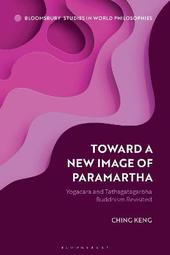
|
Toward a New Image of Paramartha: Yogacara and Tathagatagarbha Buddhism Revisited
Hardback
Main Details
Description
Yogacara and Tathagatagarbha are often regarded as antagonistic Indian Buddhist traditions. Paramartha (499-569) is traditionally credited with amalgamating these philosophies by translating one of the most influential Tathagatagarbha texts in East Asia, the Awakening of Faith in Mahayana, and introducing Tathagatagarbha notions into his translations of Yogacara texts. Engaging with the digitalized Chinese Buddhist canon, Ching Keng draws on clues from a long-lost Dunhuang fragment and considers its striking similarities with Paramartha's corpus with respect to terminology, style of phrasing, and doctrines. In this cutting-edge interpretation of the concept of jiexing, Keng demystifies the image of Paramartha and makes the case that the fragment holds the key to recover his original teachings.
Author Biography
Ching Keng is Associate Professor of Buddhist Philosophy at the National Taiwan University, Taipei, Taiwan.
ReviewsProsecuting the case that the traditional image of Paramartha is inaccurate, in this articulate and innovative monograph Ching Keng combines philological, historical and doctrinal analyses in order to recover Paramartha's authentic teachings. To that end, Keng also boldly challenges the view that Yogacara and Tathagatagarbha were antagonistic traditions in India. * John Makeham, Emeritus Professor of Chinese Studies, La Trobe University and The Australian National University, Australia * A creative and very solid study on the Indian scholar-monk Paramartha, who made a significant mark on Chinese Buddhist translation practices. With consideration toward Paramartha's diction and thought, Keng develops intriguing arguments concerning how and why the famed Awakening of Faith appeared as Paramartha's translation in medieval China. * Funayama Toru, Professor of Buddhist Studies at the Institute for Research in Humanities, Kyoto University, Japan * For well over a century Chinese, Japanese, and Western scholars have labored over the question of how, why, and with what warrant the Yogacara and Tathagatagarbha traditions of Indian Mahayana Buddhism came to be so distinctively and consequentially intertwined in Chinese Buddhist thought. The focus of these labors has long been the inestimably influential text known as the Mahayana Awakening of Faith (Dasheng qixin lun) and its alleged association with the work of the Indian Missionary Paramartha. In this learned and rigorously argued study, Keng has given us a Paramartha untethered from the Awakening of Faith thereby allowing us to see him more clearly as a faithful, albeit original, exponent of Yogacara doctrine. Keng's exemplary study will surely came to be recognized as essential to all future study of the medieval development of Chinese- and Indian - Buddhist doctrine. * Robert M. Gimello, Research Professor Emeritus of Theology and Fellow of the Liu Institute for Asia and Asian Studies, The University of Notre Dame du Lac, USA *
|